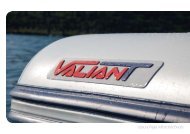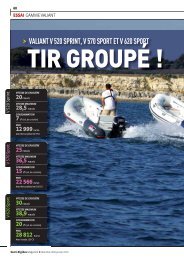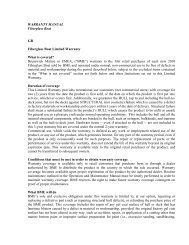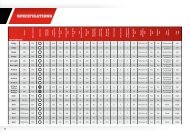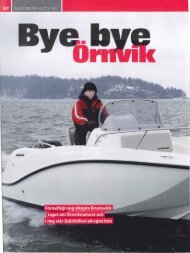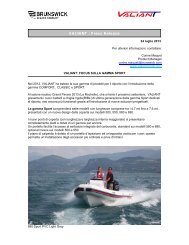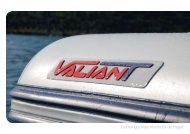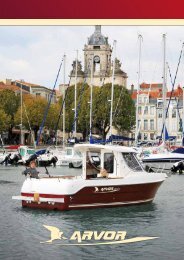899883192 - Valiant
899883192 - Valiant
899883192 - Valiant
Create successful ePaper yourself
Turn your PDF publications into a flip-book with our unique Google optimized e-Paper software.
Ventilation<br />
Section 3 - On the Water<br />
Ventilation is caused by surface air or exhaust gases that are introduced around the<br />
propeller resulting in propeller speed‐up and a reduction in boat speed. Air bubbles strike<br />
the propeller blade and cause erosion of the blade surface. If allowed to continue, eventual<br />
blade failure (breakage) will occur. Excessive ventilation is usually caused by:<br />
• Drive unit trimmed out too far.<br />
• A missing propeller diffuser ring.<br />
• A damaged propeller or gear housing, which allows exhaust gases to escape between<br />
propeller and gear housing.<br />
• Drive unit installed too high on transom.<br />
Elevation and Climate<br />
Getting Started<br />
Elevation and climate changes will affect the performance of your power package. Loss of<br />
performance can be caused by:<br />
• Higher elevations<br />
• Higher temperatures<br />
• Low barometric pressures<br />
• High humidity<br />
20‐Hour Break‐In Period<br />
For you to have optimum engine performance under changing weather conditions, it is<br />
essential that the engine be propped to allow the engine to operate at or near the top end<br />
of the specified maximum RPM range with a normal boat load during your normal boating<br />
weather conditions.<br />
In most cases, recommended RPM can be achieved by changing to a lower pitch propeller.<br />
IMPORTANT: The first 20 hours of operation is the engine break‐in period. Correct break‐in<br />
is essential to obtain minimum oil consumption and maximum engine performance. During<br />
this break‐in period, the following rules must be observed:<br />
• Do not operate below 1500 RPM for extended periods of time for the first 10 hours.<br />
Shift into gear as soon as possible after starting and advance the throttle above 1500<br />
rpm if conditions permit safe operation.<br />
• Do not operate at one speed consistently for extended periods.<br />
• Do not exceed 3/4 throttle during the first 10 hours. During the next 10 hours, occasional<br />
operation at full throttle is permissible (5 minutes at a time maximum).<br />
• Avoid full throttle acceleration from idle speed.<br />
• Do not operate at full throttle until the engine reaches normal operating temperature.<br />
• Frequently check engine oil level. Add oil as needed. It is normal for oil consumption<br />
to be high during the break‐in period.<br />
After Break‐In Period<br />
To help extend the life of your Mercury MerCruiser power package, follow these<br />
recommendations:<br />
• Ensure that propeller allows the engine to operate at or near the top of the specified<br />
WOT RPM range. Refer to Specifications and Maintenance.<br />
• Operate the engine at 3/4 throttle or lower. Refrain from prolonged operation at<br />
wide‐open‐throttle RPM.<br />
90-<strong>899883192</strong> NOVEMBER 2008 Page 55




